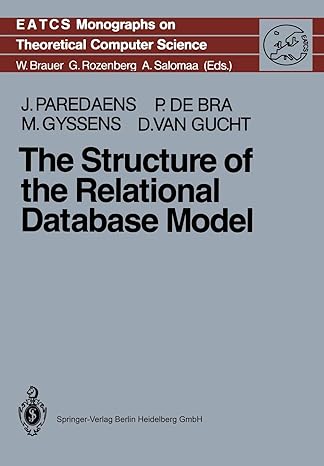Question
Write a rational number class. This problem will be revisited in chapter 11, where operate overloading will make the problem much easier. For now we
Write a rational number class. This problem will be revisited in chapter 11, where operate overloading will make the problem much easier. For now we will use member functions add, sub, mul, div, and less that each carry out the operations +, -, *, /, and <. For example, a + b will be written a.add(b), and a < b will be written a.less(b). Define a class for rational numbers. A rational number is a "ratio-nal" number, composed of two integers with division indicated. The division is not carried out, it is only indicated, as in 1/2, 2/3, 15/32, 65/4, 16/5. You should represent rational numbers by two int values, numerator and denominator. A principle of abstract data type construction is that constructors must be present to create objects with any legal values. You should provide constructors to make objects out of pairs of int values; this is a constructor with two int parameters. Since every int is also a rational number, as in 2/1 or 17/1, you should provide a constructor with a single int parameter. Provide member function input and output that take an istream and ostream argument, respectively, and fetch or write rational numbers in the for 2/3 or 37/51 to or from the keyboard (and to or from a file). Provide member functions add, sub, mul, and div that return a rational value. Provide a function less that returns a bool value. These functions should do the operation suggested by the name. Provide a member funciton neg that has no parameters and returns the negative of the calling object. Provide a main function that thoroughly tests your class implementation. The following formulas will be useful in defining functions. a/b + c/d = (a*d + b*c) / (b*d) a/b - c/d = (a*d - b*c) / (b*d) (a/b) * (c/d) = (a*c) / (b*d) (a/b) / (c/d) = (a*d) / (c*b) - (a/b) = (-a/b) (a/b) < (c/d) means (a*d) < (c*b) (a/b) == (c/d) means (a*d) == (c*b) Let any sign be carried by the numerator; keep the denominator positive.
Teachers Guidelines:
Be sure to include the following members for Rational:
a private member variables to hold the numerator and denominator values
a default constructor
an overloaded constructor that accepts two values for an initial fraction
member functions add(), sub(), mul(), div(), less(), eq(), and neq().
a member function to return the current numerator and denominator.
a member function that accepts an argument of type ostream that writes the fraction to that open output stream.
Do not let either numerator or denominator stored value go negative. Display an error message on the user terminal if any of member functions try to force a negative count value. Test programs will vary. Here is a simple test program for the Rational class:
The one member function I would add is a reduce member function. This function should compute the greatest common divisor (GCD) of the numerator and denominator, then divide each by this number. This will reduce the fraction to lowest common terms. If this is not done, the numerator and denominator can grow, possibly far enough to cause integer overflow for int variables.
Step by Step Solution
There are 3 Steps involved in it
Step: 1

Get Instant Access to Expert-Tailored Solutions
See step-by-step solutions with expert insights and AI powered tools for academic success
Step: 2

Step: 3

Ace Your Homework with AI
Get the answers you need in no time with our AI-driven, step-by-step assistance
Get Started


